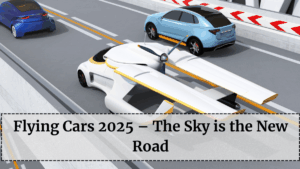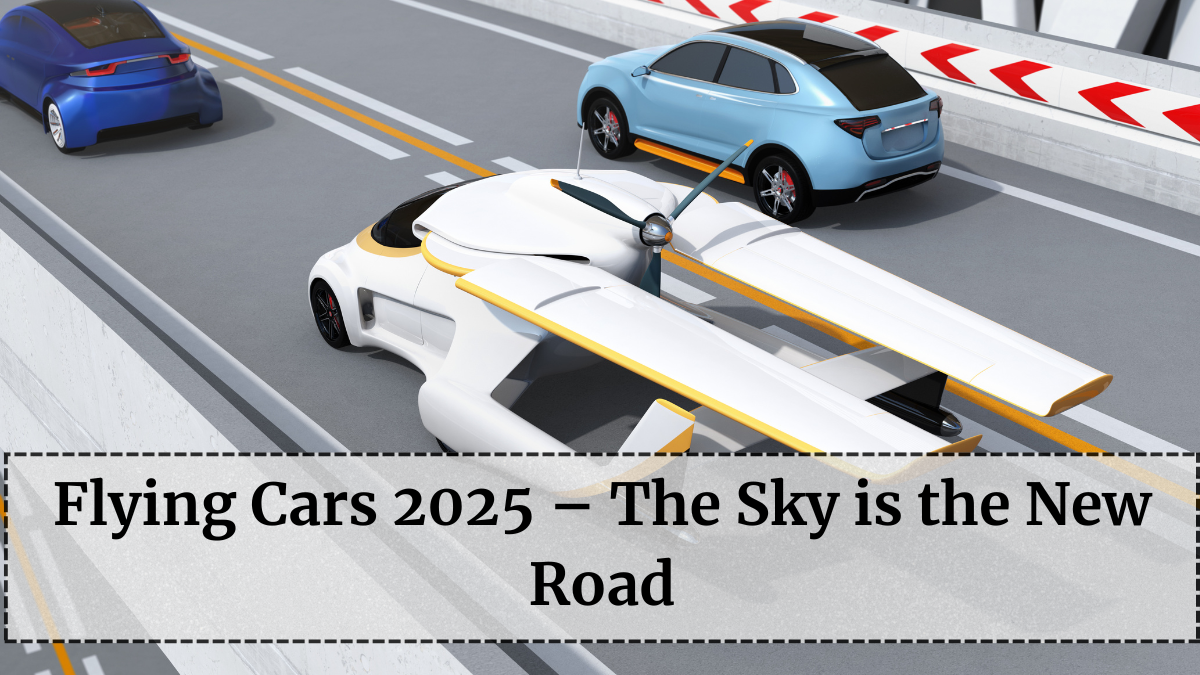For decades, flying cars existed only in sci-fi dreams. But in 2025, Urban Air Mobility (UAM) is transforming that dream into reality. With rapid advancements in electric propulsion, autonomous flight, and lightweight design, flying cars are now entering real-world testing and limited commercial service.
Global companies like Joby Aviation, Hyundai, and Archer Aviation, along with startups in India and Europe, are leading this race. The goal is simple — make short-distance flying as common as hailing a cab. Welcome to the age where the sky becomes the new road.

What Exactly Are Flying Cars?
The Concept of Air Mobility
Flying cars, officially known as eVTOLs (electric Vertical Takeoff and Landing vehicles), are hybrid machines capable of operating both as cars and small aircraft. They combine drone-like vertical flight with airplane-style forward propulsion.
These vehicles are powered by electric motors, eliminating the need for long runways and reducing emissions compared to traditional aircraft. Most eVTOLs are designed for 2–4 passengers, focusing on short urban or intercity routes.
How They Work
-
Vertical Takeoff and Landing: Propellers lift the vehicle straight up, just like a helicopter.
-
Transition Flight Mode: Once airborne, the craft tilts its propellers to move forward.
-
Autonomous Navigation: Onboard sensors and GPS handle takeoff, route control, and landing with minimal human input.
-
Battery Power: High-density lithium or solid-state batteries power the motors, enabling ranges of 100–250 km per charge.
Global Pioneers of Flying Cars in 2025
1. Joby Aviation (USA)
Joby is one of the first to receive certification trials for its eVTOL air taxi service. The five-seater can fly up to 240 km at speeds of 320 km/h, offering zero-emission urban transport.
2. Hyundai Supernal S-A2 (South Korea/USA)
Hyundai’s UAM division, Supernal, unveiled its S-A2 prototype featuring a sleek cabin and quiet propeller system designed for city use. It is expected to begin operations by 2026.
3. Archer Aviation – Midnight Air Taxi
Archer’s “Midnight” eVTOL can complete a 30-minute intercity flight with minimal noise, powered entirely by electricity. United Airlines has already partnered with Archer for future airport transfers.
4. Volocopter (Germany)
The Volocopter 2X and VoloCity models are already conducting public flight demos in Singapore and Paris. They’re expected to debut commercially during the Paris 2024 Olympics.
5. XPeng AeroHT (China)
China’s XPeng has successfully tested its foldable flying car, the X2, which can switch between driving and flight mode in seconds. It’s designed for both civilian and emergency response use.
India’s Entry into the Flying Car Revolution
India is not far behind. In 2025, several Indian startups have begun developing electric flying vehicles for short-distance logistics and passenger transport.
-
Vinata AeroMobility (Chennai): Asia’s first hybrid flying car prototype powered by biofuel and electric energy, capable of carrying two passengers.
-
The ePlane Company (IIT Madras): Developing eVTOLs for urban commutes of up to 200 km, targeting air taxi services in major cities like Bengaluru and Hyderabad.
-
Skye Air Mobility: Testing autonomous cargo drones for medical and last-mile delivery across India.
With the Drone Rules 2021 and India’s UAM policy under development, the government aims to integrate aerial mobility within urban infrastructure by 2030.
Advantages of Flying Cars
Reduced Traffic Congestion
Air taxis will help bypass ground traffic in congested urban areas, cutting commute times from hours to minutes.
Clean and Sustainable Energy
eVTOLs run on electricity or hydrogen fuel cells, producing zero tailpipe emissions and supporting global carbon-neutral goals.
Time Efficiency
A trip from Delhi Airport to Gurugram that takes 60 minutes by road could soon take under 8 minutes by air taxi.
Lower Noise and Maintenance
Electric motors make flying cars 80% quieter than helicopters, while modular parts reduce operational costs.
Emergency and Medical Applications
Flying vehicles can also serve in disaster relief, organ transport, and emergency evacuations, providing access to areas unreachable by road.
Challenges Slowing Down the Takeoff
Airspace Regulation
Air traffic management is the biggest challenge. Governments must establish low-altitude flight corridors and real-time communication systems to prevent mid-air collisions.
Battery Limitations
Despite progress, battery energy density remains a barrier to achieving longer ranges and heavier payloads.
Safety and Public Trust
Before mass adoption, flying cars must pass strict aviation safety standards. Convincing passengers to trust autonomous aerial vehicles will take time.
Infrastructure Gaps
Cities need vertiports (dedicated landing pads) and charging stations at airports, rooftops, and business hubs to support eVTOL operations.
The Future of Air Mobility
By 2030, analysts predict that flying taxis will become operational in 25 major cities worldwide, serving millions of passengers annually. Integration with public transport systems and AI-driven flight coordination networks will make air mobility both scalable and safe.
India’s roadmap includes pilot corridors between Mumbai, Pune, and Bengaluru, where hybrid eVTOLs could revolutionize intercity travel. As technology matures, costs are expected to fall by 50–60%, making aerial transport accessible to everyday users.
The future of flying cars is not just about technology — it’s about reimagining how humans move. With skies opening up as the next highway, urban mobility is ready to take flight.
FAQs
Are flying cars already available for public use?
Not yet on a large scale. However, pilot programs are underway in cities like Dubai, Singapore, and Los Angeles for testing.
How safe are flying cars?
Flying cars use redundant power systems, AI-controlled navigation, and advanced sensors to ensure maximum safety — even during emergencies.
How much will flying cars cost in India?
Initial models could cost around ₹1–2 crore, but air taxi services will make short-distance aerial rides more affordable.
Do flying cars use fuel or electricity?
Most modern models are electric (eVTOL), though some hybrid versions use biofuel or hydrogen for extended range.
When will flying cars become common in India?
Commercial flying car services could begin by 2027–2028, starting with limited routes between airports and metro business zones.
Click here to know more.
